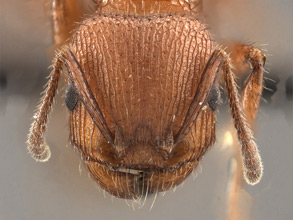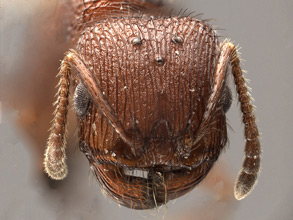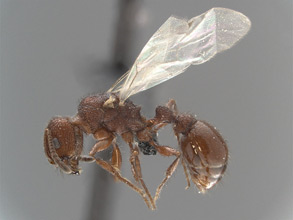- Identification
- A combination of its small size and reduced psammophore set this species apart from other Pogonomyrmex that inhabit Navajo lands.
- Biology
- Wheeler's original description of this species (Wheeler 1902a) contained what was, at the time, a remarkable observation of ant larvae feeding directly on seeds. Wheeler had maintained a colony in an artificial nest and reported the following:
During the first few days of their captivity the ants were fed on house flies. These were not only eaten with avidity by the adult Pogonomyrmex, but cut into pieces and fed to the larvae in the same manner as I have described for the Ponerinae and some Myrmicinae (1900 and 1900a).On one occasion nearly every larva in the nest could be seen munching a small piece of house fly. But a still more remarkable method of feeding was adopted after a few days, when the supply of insect food was exhausted. Then the ants were seen to bring seeds from their granary, crack them open with their strong mandibles, and, after consuming some of the softer portions themselves, to distribute the remainder among their larvae. The latter could be seen under the lens cutting away with their mandibles and devouring the softer starchy portions of the seeds. The hard and useless hulls were afterwards carried away by the ants and placed on the refuse heap, These observations show that the larvae of certain ants are not only able to subsist on solid food, but even on food of a vegetable nature. The adaptation of what were probably once exclusively carnivorous ants to a vegetable diet, although not yet complete, is, nevertheless, so far advanced that the larva already participates in the peculiar feeding habits of the adult insect. The P. imberbiculus seem not to possess the power of feeding one another or their larvae by regurgitation. At any rate they were not seen to make use of this method in the artificial nests.
- additional biology notes...
- Distribution
- Range
- United States and Mexico. Including Arizona, Oklahoma, Texas, Colorado, New Mexico, Nevada, California.
- Navajo Reservation Records
- Samples being processed.
- Additional Notes
- Pogonomyrmex are abundant and often conspicuous ants in arid low-latitude habitats of the Americas. Cole (1968) offered this well written general introduction to the genus:
The genus Pogonomyrmex is the preeminent group of harvesting ants in North America, where it nearly blankets the arid regions of Mexico and the western United States. As is true of other harvesting ants, the workers of this genus collect seeds for food, "harvesting" the plants in their nesting areas by snipping off the seeds with their mandibles. Husked within the nest and stored in subterranean or mound chambers, these highly nutritious seeds become the paramount food for the society, sustaining the ants even through the winter. Seeds are not their sole food, however, because the ants are scavengers as well as harvesters. Although their victims are chiefly arthropods, the workers may transport a varied array of dead booty to their nests.
The nests themselves are constructed in the soil, generally in areas fully exposed to the sun. Some are beneath stones, whereas others are surmounted by soil craters or by small to huge mounds with or without coverings of gravel. In addition, the workers of some species alter the area peripheral to the nests by clearing away the plants, felling them, bit by bit, with their powerful mandibles. Such mounds their surrounding denuded area, characteristic of the western harvester, are familiar sights to travelers in the arid West.
Although the workers of some species of Pogonomyrmex are extremely hostile and will vigorously attack and sting an invader, other species are contrastingly inoffensive and retiring.
- Nesting Biology
- Pogonomyrmex imberbiculus will nest in the open, under stones and at the base of grass clumps. Nests are relatively shallow and are comprised of a few broad and shallow surface chambers that are attached to a number of galleries deeper underground. The workers are quite docile and do not defend their nest when disturbed by a curious myrmecologist. Workers will act aggressively towards other Pogonomyrmex imberbiculus that are dropped near their nest entrance but are not generally aggressive to neighboring colonies' workers. Nests can be found in high densities, up to 0.14 nests per square meter. Colonies are small, containing less than 100 individuals.
- Queen Morphs
- Two types of queens are known to occur in Pogonomyrmex imberbiculus, typical winged queens and a wingless intermorph that is intermediate between a worker and a winged queen (Hienze et al. 1992). Both queen forms are capable of heading a colony although nests with an intermorph typically contain more than one inseminated intermorph-queens.
- Foraging
- Foraging is conducted individually, with seeds and dead insects making up the majority of the material collected. Foragers range up to 3 m from the nest with the average foraging trip being 0.9 m (Schilder et al. 2004). The daily pattern of foraging activity matches that of numerous other Pogonomyrmex: a morning foraging period, a respite during the hottest part of midday and a second foraging period in the afternoon and early evening.
- Etymology
- Morphological. L. imberbis beardless + L. oculus diminutive. This species does not possess a prominent psammophore or, as Creighton (1956) described "...do not have full beards, they... have goatees."
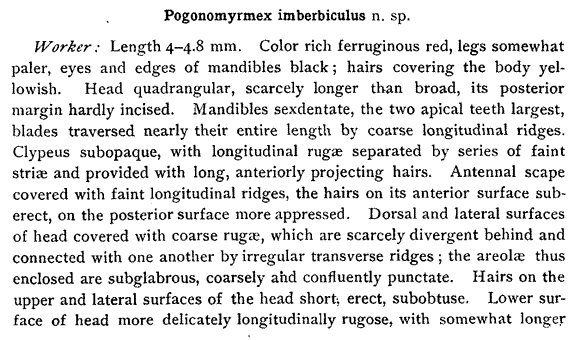

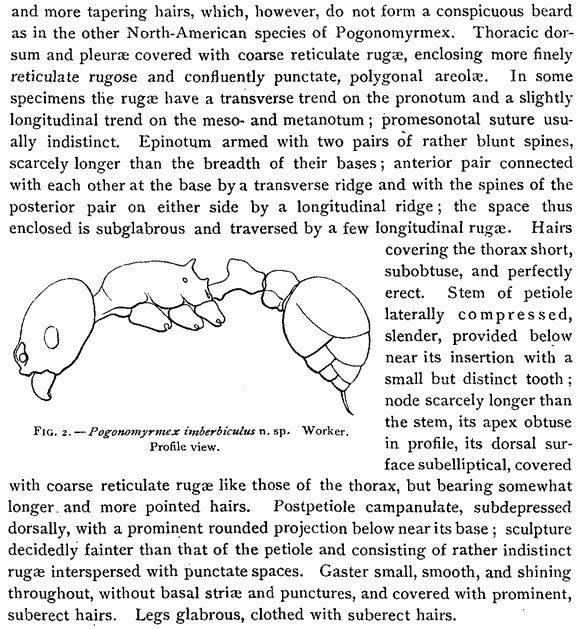
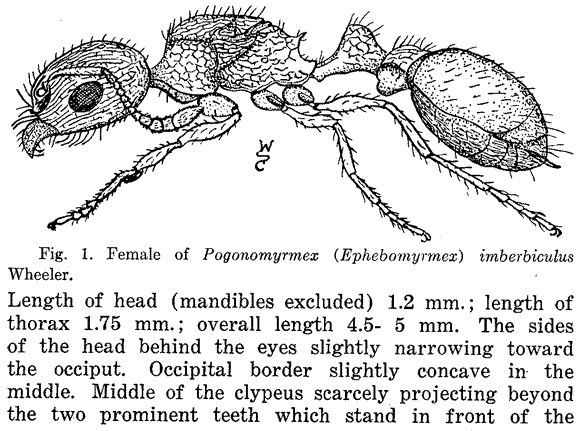

- Literature
- Cole, A. C., Jr. 1968. Pogonomyrmex harvester ants. A study of the genus in North America. University of Tennessee Press, Knoxville, Tenn.
- Creighton, W. S. 1956. Studies on the North American representatives of Ephebomyrmex (Hymenoptera: Formicidae). Psyche (Cambridge). 63:54-66.
- Heinze, J., B. Hölldobler, and S. P. Cover. 1992. Queen polymorphism in the North American harvester ant, Ephebomyrmex imberbiculus. Insectes Sociaux. 39:267-273.
- Schilder, K., B. Hölldobler, and J. Heinze. 2004. Foraging biology of the seed-harvesting ant, Pogonomyrmex (Ephebomyrmex) imberbiculus (Hymenoptera: Formicidae). Sociobiology. 43:367-375.
- Wheeler, W. M. 1902. A new agricultural ant from Texas, with remarks on the known North American species. American Naturalist. 36:85-100.
- Whitford, W. G. 1978. Structure and seasonal activity of Chihuahua desert ant communities. Insectes Sociaux. 25:79-88.
- A note about these publications. The literature cited here is not meant to be an exhaustive list of papers published about this species.
Page authored by David Lubertazzi and Gary Alpert
